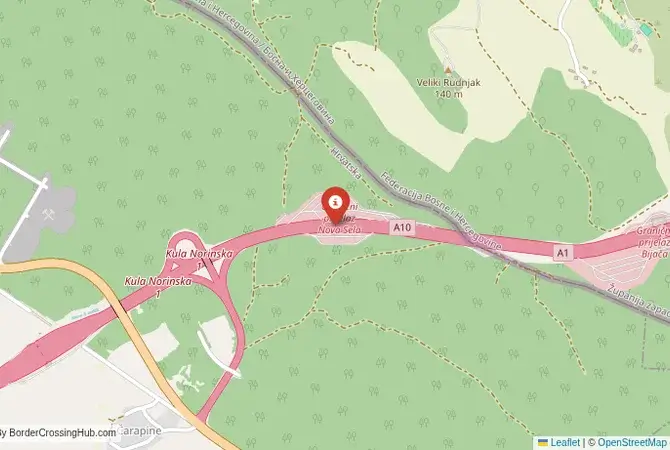
Approximate Border Location
Border Countries
Border Cities
- 🇧🇦Bijaca
- 🇭🇷Nova Sela
Wait Times
15-60 min for pedestrians/vehicles
Operating Hours
Open 6:00 AM – 10:00 PM
Crossing Types
Pedestrians, vehicles
Border Type
Land crossing via road
Peak Times
Mornings (7-10 AM)
Daily Crossings
~2000 travelers/vehicles
Currency Exchange
Limited near Bijaca (BAM, EUR)
Safety Information
Rural, minimal crime
Languages Spoken
Bosnian/Croatian
Accessibility Features
Ramps, assistance
About Bijaca & Nova Sela
The Main Motorway to the Dalmatian Coast
The border crossing connecting Bijača in Bosnia and Herzegovina with Nova Sela in Croatia is the primary southern motorway checkpoint between the two nations. This is a modern, state-of-the-art facility on the A1 motorway, a critical link for tourism and trade. Since Croatia is a member of the European Union and the Schengen Area, this is a major external border. To cross here is to travel from the sun-drenched, rocky landscape of Herzegovina directly onto the main highway that leads to the spectacular Dalmatian coast. It is a crossing defined by the flow of summer tourists, a fast and efficient gateway to the Adriatic Sea.
Operational Details
This checkpoint connects the West Herzegovina Canton of Bosnia and Herzegovina with Croatia’s Dubrovnik-Neretva County. It is a massive, multi-lane motorway crossing, open 24/7. The facility, opened in 2013, was designed to be the main entry point for traffic from Bosnia and Herzegovina to the southern part of the Croatian A1 motorway, the main artery to Split and Dubrovnik. It handles a huge volume of tourist traffic in the summer, as well as a significant amount of freight. It is the most modern and efficient crossing in the region.
Before Crossing
Crossing borders gets messy sometimes, think political flare-ups or gates shutting fast. Good travel insurance is a must for handling doctor visits, trip disruptions, or security scares. Don’t get caught unprepared. To find a policy that’s got your back, check out reliable plans today for peace of mind.
A History of a New Connection
The history of this crossing is very recent and is a story of modern infrastructure development. For decades, the only crossings in this region were smaller, local roads that were not equipped to handle heavy traffic. The construction of the Croatian A1 motorway to the south and the corresponding motorway section in Bosnia and Herzegovina created the need for a new, high-capacity border crossing. The Bijača-Nova Sela checkpoint was a major joint project, co-funded by the European Union, designed to integrate Bosnia and Herzegovina more closely with the European transport network and to boost the tourism-driven economy of the entire region. It is a symbol of a new era of connectivity.
The Schengen Border Procedure
The border crossing procedure is a rigorous and meticulous process, reflecting its status as a primary entry point into the EU and the Schengen Area. You will first complete exit formalities at the Bosnian checkpoint at Bijača. After a short drive, you will arrive at the Croatian checkpoint at Nova Sela for a full EU/Schengen entry inspection by the Croatian Border Police and Customs. You will need a valid passport. National ID cards are only sufficient for EU citizens. Vehicle registration and international insurance (Green Card) are also necessary. As a Schengen entry point, the checks are very thorough. However, the modern, multi-lane facility is designed to process traffic as efficiently as possible, and the queues are generally more manageable than at some of the older, more congested crossings.
The Surrounding Region: Bosnia and Herzegovina Side
On the Bosnian side, the crossing is in the heart of Herzegovina, a region known for its rugged limestone mountains, its sunny climate, and its wine production. The main attraction of the region is the magnificent Kravica Waterfall, a stunning series of cascades on the Trebižat River, which is a popular spot for swimming and recreation. The historic town of Ljubuški is the main regional center. The crossing is also a gateway to the famous Catholic pilgrimage site of Medjugorje and the historic city of Mostar, with its UNESCO-listed Old Bridge.
The Surrounding Region: Croatia Side
On the Croatian side, the crossing is the gateway to the beautiful Dalmatian coast. The A1 motorway provides a fast connection to the Makarska Riviera, with its stunning beaches at the foot of the Biokovo mountains, and to the major city of Split, with the magnificent Diocletian’s Palace, a UNESCO World Heritage site. The crossing also provides access to the Neretva River delta, a unique wetland landscape known for its mandarin orange groves, and to the port of Ploče, with ferry connections to the Pelješac peninsula.
Practical Travel Information
Practical planning for this route is straightforward. The most important thing is to have the required motorway vignettes or toll payments for both countries. Both Croatia and Bosnia and Herzegovina use a toll system for their motorways. The official currencies are the Bosnian Convertible Mark (BAM) in Bosnia and Herzegovina and the Euro (EUR) in Croatia. Large service stations are available on the motorway on both sides of the border. Ensure your vehicle’s Green Card insurance is valid for both countries.
Final Considerations
The Bijača–Nova Sela border crossing is a powerful symbol of modern infrastructure and European integration. It is a fast and efficient gateway that has transformed travel between Herzegovina and the Dalmatian coast. It offers a seamless passage for the millions of tourists who visit the region each year. It is a border that is designed for connection, a state-of-the-art facility that is helping to build a more prosperous and integrated future for this beautiful and historic corner of the Adriatic.
See other crossings between Bosnia and Herzegovina and Croatia
See other crossings between Bosnia and Herzegovina and Croatia
No reviews yet.
